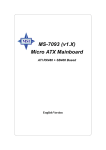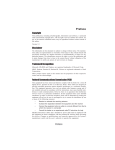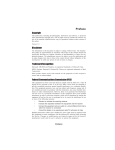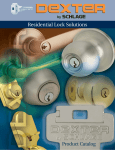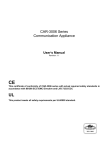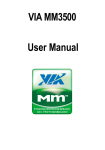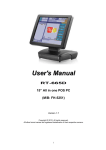Download User Manual
Transcript
Embedded Board BNX-M81 Always at the forefront of innovation User Manual 1 Copyright This publication contains information that is protected by copyright. No part of it may be reproduced in any form or by any means or used to make any transformation adaptation without the prior written permission from the copyright holders. This publication is provided for informational purposes only. The manufacturer makes no representations or warranties with respect to the contents or use of this manual and specifically disclaims any express or implied warranties of merchantability or fitness for any particular purpose. The user will assume the entire risk of the use or the results of the use of this document. Further, the manufacturer reserves the right to revise this publication and make changes to its contents at any time, without obligation to notify any person or entity of such revisions or changes. © 2011. All Rights Reserved. Trademarks All trademarks and registered trademarks of products appearing in this manual are the properties of their respective holders. FCC and DOC Statement on Class A This equipment has been tested and found to comply with the limits for a Class A digital device, pursuant to Part 15 of the FCC rules. These limits are designed to provide reasonable protection against harmful interference when the equipment is operated in a residential installation. This equipment generates, uses, and can radiate radio frequency energy and, if not installed and used in accordance with the instruction manual, may cause harmful interference to radio communications. However, there is no guarantee that interference will not occur in a particular installation. If this equipment does cause harmful interference to radio or television reception, which can be determined by turning the equipment off and on, the user is encouraged to try to correct the interference by one or more of the following measures: Reorient or relocate the receiving antenna. Increase the separation between the equipment and the receiver. Connect the equipment into an outlet on a circuit different from that to which the receiver is connected. Consult the dealer or an experienced radio TV technician for help. Notice: 1. The changes or modifications not expressly approved by the party responsible for compliance could void the user’s authority to operate the equipment. 2. Shielded interface cables must be used in order to comply with the emission limits. 2 Warranty 1. Warranty does not cover damages or failures that are raised from misuse of the product, inability to use the product, unauthorized replacement or alteration of components and product specifications. 2. The warranty is void if the product has been subject to physical abuse, improper installation, modification, accidents or unauthorized repair of the product. 3. Unless otherwise instructed in this user’s manual, the user may not, under any circumstances, attempt to perform service, adjustments or repairs on the product, whether in or out of warranty. It must be returned to the purchase point, factory or authorized service agency for all such work. 4. We will not be liable for any indirect, special, incidental or consequential damages to the product that has been modified or altered. Static Electricity Precautions It is quite easy to inadvertently damage your PC, system board, components or devices even before installing them in your system unit. Static electrical discharge can damage computer components without causing any signs of physical damage. You must take extra care in handling them to ensure against electrostatic build-up. 1. To prevent electrostatic build-up, leave the system board in its anti-static bag until you are ready to install it. 2. Wear an antistatic wrist strap. 3. Do all preparation work on a static-free surface. 4. Hold the device only by its edges. Be careful not to touch any of the components, contacts or connections. 5. Avoid touching the pins or contacts on all modules and connectors. Hold modules or connectors by their ends. Important: Electrostatic discharge (ESD) can damage your processor, disk drive and other components. Perform the upgrade instruction procedures described at an ESD workstation only. If such a station is not available, you can provide some ESD protection by wearing an antistatic wrist strap and attaching it to a metal part of the system chassis. If a wrist strap is unavailable, establish and maintain contact with the system chassis throughout any procedures requiring ESD protection. 3 Safety Measures To avoid damage to the system: • Use the correct AC input voltage range. To reduce the risk of electric shock: • Unplug the power cord before removing the system chassis cover for installation or servicing. After installation or servicing, cover the system chassis before plugging the power cord. Battery: • Danger of explosion if battery incorrectly replaced. • Replace only with the same or equivalent type recommend by the manufacturer. • Dispose of used batteries according to local ordinance. Before Using the System Before using the system, prepare basic system components. If the system comes as a barebone; that is, none of the key components, including processor, memory, and hard drive has been pre-installed as part of your purchase, you will need to at least ensure a compatible counterpart is located and installed. You will also need a few external system peripherals intended for the use of the system, a common pool with at least a keyboard, a mouse, and a monitor is thus suggested. 4 Table of Content Copyright .................................................................................................................................................................... 2 Trademarks .................................................................................................................................................................... 2 FCC and DOC Statement On Class A.............................................................................................................................. 2 Warranty ........................................................................................................................................................................ 3 Static Electricity Precautions ......................................................................................................................................... 3 Safety Measures ............................................................................................................................................................ 4 Before Using the System Board ..................................................................................................................................... 4 Table of Content ............................................................................................................................................................ 5 Chapter 1 General Information 1.1 Main Feature ........................................................................................................................................................... 7 1.2 Specifications ....................................................................................................................................................... 8 1.3 Board Layout ..................................................................................................................................................... 9 Chapter 2 Jumper Setting 2.1 Before You Begin ..................................................................................................................................... 11 2.2 Precautions......................................................................................................................................................... 11 2.3 Setting Jumpers .................................................................................................................................................. 12 2.4 Back Panel Connectors ....................................................................................................................................... 13 2.5 Location of Jumpers and Connectors.............................................................................................................. 14 2.6 Jumpers........................................................................................................................................................... 16 2.7 Internal Connectors ........................................................................................................................................ 21 Chapter 3 Operation 3.1 System Memory .............................................................................................................................................. 29 3.2 Installing Memory ...................................................................................................................................... 29 3.3 Installing LGA1150 Intel® Core-i CPU, Heat Sink, and Fan ............................................................................... 30 3.4 Adding Power Connectors .............................................................................................................................. 33 3.5 Adding PCIe/PCI Cards .................................................................................................................................... 34 3.6 Install a PCI Express Mini Card in the Full-Mini Card Slot ............................................................................... 35 Chapter 4 BIOS Setup 4.1 Entering Setup ................................................................................................................................................ 38 4.2 Getting Help .................................................................................................................................................... 38 4.3 Control Keys .................................................................................................................................................... 38 4.4 The Main Menu ............................................................................................................................................... 39 4.5 The Advanced Menu........................................................................................................................................ 40 4.6 The Chipset Menu..................................................................................................................................................... 44 4.7 The Boot Menu................................................................................................................................................ 46 4.8 The Security Menu .......................................................................................................................................... 48 4.9 The Save & Exit Menu ...................................................................................................................................... 50 5 Chapter 1 General Information 6 1.1 Main Feature Micro-ATX System Board BNX-M81 is a standard Micro-ATX motherboard featuring Intel® H81 PCH chipset supports Intel® Gen-4 Core™ processor and two Dual Channel DDR3 SO-DIMM slots up to 16GB DDR3 1066/1333/1600MHz SDRAM with Non-ECC support and integrated HD graphic controller. Intel® Gen-4 LGA1150 Haswell Processor Two DDR3 RAM Slots up to 16GB Two SATA Ports: 2* SATA 3.0 Two Display Ports: VGA, DVI-D Ten Series Ports: 2* Edge RS-232/422/485, 8* RS-232 Headers Six USB 2.0 Ports: 6* Internal Ports Four USB 3.0 ports: 4* Edge Ports Two Realtek GbE LAN Ports 1* Full-sized miniPCIe Slot 1* Half-sized miniPCIe Slot 1* PCIe 3.0 X16 Slot 1* PCIe 2.0 X1 Slot 2* PCI Slots 7 1.2 Specifications Core Engine Chipset Intel® H81 PCH Processor Support Intel® Gen-4 Core i3, i5, i7, Pentium® , Celeron® Processor Single LGA1150 Processor Socket Memory 2x DDR3 1066/1333 SO-DIMM Slots, up to 16GB, Non-ECC/Non-Buffered Memory Module Display Intel® HD Graphics 4600 Ethernet Controller Onboard 2x Realtek RTL8111G GbE Controllers Storage SATA 2x SATA3 Ports PCIe X16 1x PCIe X1 1x PCI 2x miniPCIe 1x Full-sized + 1x Half-sized PS/2 2x PS/2 for Keyboard and Mouse COM 2x DB9 RS-232 Display 1x DB15 VGA + 1x DVI-I USB 4x USB 3.0 Ports LAN 2x RJ45 GbE Audio 3x Audio Jacks Front Panel 1x Front Panel Switch/LED Header LPT 1x Parallel Box Header COM 8x RS-232 Pin Header USB 6x USB 2.0 Pin Headers Fan 3x Fan Connectors H/W Monitoring Monitor temperature, voltage, and fan speed, auto-throttling control at CPU overheat WDT 1 min increment from 1 to 255 min, 1 sec increment from 1 to 255 sec Operating Temp. 0oC ~ 60oC Storage Temp. -20oC ~ 70oC Humidity 10% ~ 90% (Non-Condensing) Dimension 244mm (W) x 244mm (D) Expansion Edge I/O Internal I/O Other Environment Mechanical 8 1.3 Board Layout Figure 1.1: Board Layout of BNX-M81 9 Chapter 2 Preparation 10 2.1 Before You Begin A stable and clean working environment are essential. Dust and dirt can get into components and cause a malfunction. Use containers to keep small components separated. Adequate lighting and proper tools can prevent you from accidentally damaging the internal components. Most of the procedures that follow require only a few simple tools, including the following: A Philips screwdriver A flat-tipped screwdriver A set of jewelers Screwdrivers A grounding strap An anti-static pad Using your fingers can disconnect most of the connections. It is recommended that you do not use needle-nosed pliers to disconnect connections as these can damage the soft metal or plastic parts of the connectors. Before working on internal components, make sure that the power is off. Ground yourself before touching any internal components, by touching a metal object. Static electricity can damage many of the electronic components. Humid environment tend to have less static electricity than dry environments. A grounding strap is warranted whenever danger of static electricity exists. Computer components and electronic circuit boards can be damaged by discharges of static electricity. Working on the computers that are still connected to a power supply can be extremely dangerous. Follow the guidelines below to avoid damage to your computer or yourself: Always disconnect the unit from the power outlet whenever you are working inside the case. If possible, wear a grounded wrist strap when you are working inside the computer case. Alternatively, discharge any static electricity by touching the bare metal chassis of the unit case, or the bare metal body of any other grounded appliance. Hold electronic circuit boards by the edges only. Never touch the components on the board unless it is necessary to do so. Do not flex or stress the circuit board. Leave all components inside the static-proof packaging that they shipped with until they are ready for installation. Use correct screws and do not over tighten screws. 11 2.3 A jumper is the simplest kind of electric switch. It consists of two metal pins and a cap. When setting the jumpers, ensure that the jumper caps are placed on the correct pins. When the jumper cap is placed on both pins, the jumper is SHORT. If you remove the jumper cap, or place the jumper cap on just one pin, the jumper is OPEN. Please see the following illustrations The illustrations on the right show a 2-pin jumper. When the jumper cap is placed on both pins, the jumper is SHORT. If you remove the jumper cap, or place the jumper cap on just one pin, the jumper is OPEN. Open (Off) Short (On) These illustrations show a 3-pin jumper. Pins 1 and 2 are SHORT. Table 2-1: Setting Jumpers 12 2.4 Back Panel Connectors 1. 2. 3. 4. 5. 6. 7. 8. 9. 10. 11. 12. 13. PS/2 Mouse (Green) DB15 VGA DB9 RS-232 LAN1 LAN2 Line-In Jack Line-Out Jack Microphone Jack 2* USB 3.0 2* USB 3.0 DB9 RS-232 DVI-I PS/2 Keyboard (Purple) 13 2.5 Locations Of Jumpers and Connectors 14 List of Onboard Connectors 1 2 3 4 5 6 AUDIO Audio connectors USB_LAN2 RJ45 LAN port (top) / USB 2.0 ports (buttom) USB_LAN1 RJ45 LAN port (top) / USB 2.0 ports (buttom) COM34 Serial ports VGA_DVI VGA port (top)/DVI port (buttom) JCOM5 JRS23 JRS22 JRS27 JRS29 RS232/RS422/RS485 Select Jumper for COM4 7 8 9 COM5 Serial port cable connector #5 COM6 Serial port cable connector #6 JRS14 JRS15 JRS22 JRS19 JCOM3 RS232/RS422/RS485 Select Jumper for COM3 10 11 12 13 14 15 16 17 18 19 20 21 22 23 24 25 26 27 ATX_12V 4 pin power connector COM8 Serial port cable connector #8 COM7 Serial port cable connector #7 JCOM6 COM6 Power Select jumper COM9 Serial port cable connector #9 JCOM8 COM10 Power Select jumper COM10 Serial port cable connector #10 CPU Intel LGA 1155 socket CPU_FAN CPU fan connector SODIMMA DDR3 SO-DIMM slot SODIMMB DDR3 SO-DIMM slot LPT LPT connector MIN_PCIE1 Mini PCi Express connector MIN_PCIE2 Mini PCi Express connector JRS9 LVDS Enable Jumper JRS10 LVDS Enable Jumper JRS8 LVDS Enable Jumper JRS7 LVDS Enable Jumper 15 28 29 30 31 32 33 34 35 36 37 38 39 40 41 42 43 44 45 46 47 48 49 50 51 LVDS LVDS connector BKL_CN LCD Inverter Connector JRS6 LVDS Enable Jumper ATX 24 pin main power connector SYS_FAN2 System fan connector #2 SATA1/SATA2 SATA 3Gb/s connectors F_PANEL Front Panel header GPIO_CNT GPIO connector F_USB3 Front USB 2.0 header #3 F_USB2 Front USB 2.0 header #2 F_USB1 Front USB 2.0 header #1 BATTERY Battery socket LPC LPC connector CI Case open intrusion header CLR_CMOS Clear CMOS jumper COM1 Serial port cable connector #1 COM2 Serial port cable connector #2 F_AUDIO Front audio header SPK_OUT Audio Amplifier connector PCI2 PCI 32bit/33MHz slot PCI1 PCI 32bit/33MHz slot PCIE1X1 PCI Express x1 slot PCIE16X1 PCI Express x16 slot SYS_FAN System fan connector 16 2.6 Jumpers ► COM3 RS-232/422/485 Selection Jumper JRS14/JRS15/JRS21/JRS19 Pin 1-2 Closed 2-3 Closed Definition RS-422/485 RS-232 JCOM3 Pin Definition 1-2 Closed RS-232 3-4 Closed RS-422 5-6 Closed RS-485 17 ► COM5 RS-232/422/485 Selection Jumper JRS23/JRS22/JRS27/JRS29 Pin 1-2 Closed 2-3 Closed Definition RS-422/485 RS-232 JCOM5 Pin Definition 1-2 Closed RS-232 3-4 Closed RS-422 5-6 Closed RS-485 18 ► JCOM6 / JCOM8 Pin#9 (RI) Selection Jumper Pin Definition 1-2 Closed 5V 3-4 Closed RI 5-6 Closed 12V ► JRS9 / JRS10 / JRS8 / JRS7 / JRS6 (LVDS Enable Jumper) JRS6 Pin 1-2 Closed 2-3 Closed JRS7 / JRS8 / JRS9 / JRS10 Jumper 1024 x 600 JRS7 JRS8 JRS9 JRS10 Definition Enable LVDS Disable LVDS 1024 x 768 19 ► CLR_CMOS (Clear CMOS Jumper) Pin Open Close Definition Normal Operation Clear CMOS 20 2.7 Internal Connectors 24-pin ATX Power Connector / 4-pin 12V Power Connector Pin 1 2 3 4 Definition GND GND +12V +12V Pin Definition 1 2 3 4 5 6 7 8 9 3.3V 3.3V GND +5V GND +5V GND Power OK 5VSB (stand by +5V) +12V +12V 3.3V 10 11 12 Pi n 13 14 15 16 17 18 19 20 21 Definition 22 23 24 +5V 3.3V -12V GND PS_ON GND GND GND NA +5V +5V GND 21 SATA1/SATA2 Connector Pin 1 2 3 4 5 6 7 8 9 Definition GND TXP TXN GND RXN RXP GND VCC GND Pin 1 2 3 4 Definition GND +12V Sense Speed Control 4-pin CPU/System Fan Connector 22 USB1 / USB2 / USB3 Connector Pin 1 3 5 7 9 Definition 5V DD+ GND Pin 2 4 6 8 10 Definition 5V DD+ GND NC Pin 1 3 5 7 9 Definition RXD DTR DSR CTS NC Pin 2 4 6 8 10 Definition DCD TXD GND RTS RI Serial Port Connector Remark: Pin#9 (RI) of COM9/COM10 can be adjusted with 5V/12V output via Jumper. 23 F_Audio Connector (Front Panel Audio Header) Pin 1 3 5 7 9 Definition MIC_L MIC_R HPOUT_R FAUDIO_JD HPOUT_L Pin 1 2 3 4 Definition OUT_R+ OUT_ROUT_LOUT_L+ Pin 2 4 6 8 10 Definition -AGND -ACZ_DET SRTN1 NC SRTN2 SPK_OUT (Audio Amplifier Connector) 24 GPIO_CNT (GPIO Connector) Pin 1 3 5 7 9 11 Definition GPIO1 GPIO6 GPIO7 GPIO17 SMBCLK VCC Pin 2 4 6 8 10 12 Definition GPIO68 GPIO69 GPIO70 GPIO71 SMBDATA GND Pin 1 2 3 4 5 6 7 8 9 10 11 12 13 14 15 Definition STBPD3 GND GND AFDPD4 GND GND PD0 PD5 GND GND ERRPD6 GND Pin 16 17 18 19 20 21 22 23 24 25 26 27 28 29 30 Definition GND PD1 PD7 GND GND INITACKGND GND PD2 BUSY GND PE SLINSLCT LPT Connector 25 F_PANEL (Front Panel Connector) Pin 1 2 3 4 5 6 7 8 9 10 Signal Name HD+ MPD+ HDGND GND -PWRBT_F -SYS_RST GND NC NC Pin 1 2 3 4 5 Definition Definition Hard Disk LED Signal anode (+) Power LED Signal anode (+) Hard Disk LED Signal cathode(-) Ground Ground Power Button cathode(-) Reset Button Ground No connect No Pin BLK_CN (LCD Inverter Connector) VCC PWM_OUT ENABKL GND +12V 26 LVDS (LVDS Header) Pin 1 2 3 4 5 6 7 8 9 10 11 12 13 14 15 16 17 18 19 20 Signal Name VCC3 VCC VCC3 VCC SPC0 SPD0 GND GND A1P_C A0P_C A1M_C A0M_C GND GND A3P_C A2P_C A3M_C A2M_C GND GND Pin 21 22 23 24 25 26 27 28 29 30 31 32 33 34 35 36 37 38 39 40 Signal Name A5P_C A4P_C A5M_C A4M_C GND GND A7P_C A6P_C A7M_C A6M_C GND GND CLK2P_C CLK1P_C CLK2M_C CLK1M_C GND GND +12V +12V CI (Case Open Inverter Connector) Pin Open Close Definition Normal Operation Alert Active 27 Chapter 3 Operation 28 3.1 System Memory BNX-M81 has Intel® H81 chipset built-in, and supports dual channel non-ECC, un-buffered DDR31066/1333/1600MHz memory modules. Two SO-DIMM slots support up to 16GB Memory Capacity. 3.2 Installing Memory To install Memory 1. Make sure the “Key” on Memory module and slot are perfectly matched, and add slowly the RAM module into the slot. 2. Push the RAM module right up until the module is snapped in the slot by both side clips. 3. To remove the Memory modules, please push the clips outwards, and the memory modules will be automatically disengaged. 29 3.3 Installing LGA1150 Intel® Core-i CPU, Heatsink, and Fan BNX-M81 supports Intel® LGA1150 Gen-4 Core-i Processor. For a reference list of supported processor, please refer to the specification section. The socket 1150 is formed up with sensitive arrays of pins, improper or careless installation may cause permanent harm to the socket pins. In some cases users may accidentally damage the socket simply by adjusting the position of the CPU. Please follow the installation instructions as shown below: Step (A): Opening the Socket 1. Push the “Socket Lever” down and away from the socket to release it. 2. Rotate the “Socket Lever” to lift the “Load Plate” away from the socket. 3. Make sure the “Load Plate” is in the fully open position, and also remove the socket cover. 4. When opening the socket, DO NOT TOUCH the gold socket contacts. 30 Step (B): Install the Processor 1. Hold the processor with your thumb and index finger as shown to align your fingers with the socket cutouts. 2. Make sure that the processor Pin#1 indicator (gold triangle) is aligned with the Pin#1 chamfer on the socket. 3. Make sure that the notches on the processor align with the posts on the socket. 4. Lower the processor straight down without tilting or sliding it in the socket. Step (C): Close the Load Plate 1. Carefully lower the “Load Plate” and make sure it slides under the shoulder screw cap as the lever is lowered. 2. Continue to low the lever. 3. Latch the socket lever under the load plate tab. 31 Step (D): Install a Heatsink Note: Heatsinks that come with boxed Intel® processors use pre-applied Thermal Interface Material (TIM) and do not need thermal grease. If a different heatsink is used, please refer to manufacturer’s instructions. 1. Place the heatsink onto the processor socket. Ensure that the fan power cable is on the side closet to the processor fan header. 2. Align the fasteners with the corresponding board holes (four of them). Ensure that the fasteners slots are pointing perpendicular to the heatsink. 3. While pressing down on the heatsink, press down on the top of the fasteners with your thumb to lock into place. Ensure that all four fasteners are secured. 4. Connect the heatsink fan power cable to the processor fan header. 32 3.4 Adding Power Connectors BNX-M81 motherboard requires correct power plan to properly support Intel® LGA1150 Gen-4 Core-i Processor. Please add the 24-pin ATX Power Connector on the blue connector, and 4-pin 12Vdc Power Connector on the red connector In case the 12Vdc Power Connector is not added, power supply will be triggered, but the motherboard would not boot at all. Please shutdown the system, and add the 12Vdc Power Connector back on. 33 3.5 Adding PCIe/PCI Cards BNX-M81 motherboard comes with 2* PCIe Slots and 5* PCI Slots. Prior to add your expansion card onto these slots, please: (1) Identify the type of expansion card to be added. In the picture below: Color Blue Yellow White Definition 5* PCI Slots 1* PCIe X1 Slot 1* PCIe X16 Slot Signal PCI Signal PCIe 2.0 X1 Signal PCIe 3.0 X16 Signal. Deployment 5V or Universal PCI Good for PCIe X1 Good for all PCIe Cards (2) Shutdown the system (would be nice to cut the power) if system is running. (3) Plug in the cards and put the power back on. (4) Please refer to the application notes of user’s manual of the expansion card to load driver files or initiate the expansion cards. 34 3.6 Install a PCI Express Mini Card in the Full-Mini Card Slot The Full-Mini Card slot can only be used with a Full-sized PCI Express Mini Card. PCI Express Full-Mini Card Installation: (A) If a screw is found in the stand-off, please remove the screw. (B) Align the notch in the card with the socket key and insert the card at a slightly upward angle as shown. (C) Push down on the card and secure with one screw. 35 Chapter 4 BIOS Setup 36 About the BIOS The BIOS (Basic Input and Output System) Setup program is a menu driven utility that enables you to make changes to the system configuration and tailor your system to suit your individual work needs. It is a ROM-based configuration utility that displays the system’s configuration status and provides you with a tool to set system parameters. These parameters are stored in non-volatile battery-backed-up CMOS RAM that saves this information even when the power is turned off. When the system is turned back on, the system is configured with the values stored in CMOS. With easy-to-use pull down menus, you can configure such items as: Hard drives, diskette drives, and peripherals Video display type and display options Password protection from unauthorized use Power management features When to Run BIOS This program should be executed under the following conditions: When changing the system configurations. When a configuration error is detected by the system and you are prompted to make changes to the Setup program. When resetting the system clock. When setting the CPU clock speed so that it automatically runs either fast or slow. When redefining the communication ports to prevent any conflicts. When making changes to the Power Management configuration. When changing the password or making other changes to the security setup. Normally, CMOS setup is needed when the system hardware is not consistent with the information contained in the CMOS RAM, whenever the CMOS RAM loses power, or when the system features need to be changed. When to Update BIOS In the event that new features are released and a BIOS update is required, you will need to update your BIOS on your own, with the help of an appropriate guide, a reference tool, and some command files for the job. Please seek for help from your local dealer, or send your request to our technical support department. 37 4.1 Entering Setup When the system is powered on, the BIOS will initiate the Power-On-Self-Test (POST) routines. These routines perform various diagnostic checks. If an error is encountered, the error will be reported in one of two different ways: If the error occurs before the display device is initialized, a series of beeps will be transmitted. If the error occurs after the display device is initialized, the screen will display the error message. Powering on the computer and immediately pressing <Del> allows you to enter Setup. Another way to enter Setup is to power on the computer and wait for the following message during the POST: TO ENTER SETUP BEFORE BOOT PRESS <CTRL-ALT-ESC> OR <DEL> KEY Press the <Del> key or press the <Ctrl>, <Alt>, and <Esc> keys to enter Setup. 4.2 Getting Help The online description of the highlighted setup item is displayed at the right pane of the menu at all time. Press F1 to pop up a small help window that lists all the function keys and its use. To exit the Help Window, press <F1> or <Esc>. 4.3 Control Keys The table below lists all the function keys for the navigation in the BIOS setup menu. Function Key Description Up/Down Arrow Key Move Up/Down Left/Right Arrow Key Move Left/Right Enter Key Select +/- Key Change value ESC Exit F1 General Help F2 Previous Values F9 Optimized Defaults F10 Save & Exit BIOS Setup Menu To exit the Help Window, press <F1> or <Esc>. 38 4.4 The Main Menu The menu bar on the top of the first screen has the following submenus: Main: Basic system configuration. Advanced: Advanced system settings. Chipset: Chipset settings Boot: System boot configuration. Security: BIOS security settings. Save & Exit: Exit options as well as loading optimal defaults System Date [Day xx/xx/xxxx]: Set the system date. System Time [xx:xx:xx]: Set the system time. 39 4.5 The Advanced Menu Wake On Lan from S5 Enable/Disable Wake-On-LAN from S5 Options: Enabled/Disabled. Default setting is Enabled. ACPI Settings ACPI Sleep State Select the ACPI sleep state which the system will move forward when the suspend button is pressed. Options: Suspend Disabled/S1 only (CPU Stop Clock)/S3 only (Suspend to RAM). Default setting is S3 only (Suspend to RAM). S5 RTC Wake Settings Wake System with Fixed Time [Disabled] Enabled to wake up system at the specified hr::min::sec alarm event. Wake up day/hour/minute/second Specify the values for day/hour/minute/second. *This setting is available only when Wake System with Fixed Time is enabled. 40 Trusted Computing Security Device Support Enabled to wake up system at the specified hr::min::sec alarm event. Enable/Disable BIOS support for security device. Options: Enabled/Disabled. Default setting is Disabled. CPU Configuration Active Processor Cores Select the number of CPU cores to be enabled. Options: All/1/2/3. Default setting is All. Execute Disable Bit Enable/Disable the protection against buffer overflow attacks Options: Enabled/Disabled. Default setting is Enabled. Intel Virtualization Technology Enabl/Disable Intel Virtualization Technology function. Options: Enabled/Disabled. Default setting is Enabled. EIST (Enhanced Intel SpeedStep Technology) Enable/Disable Intel® SpeedStep Technology Options: Enabled/Disabled. Default setting is Enabled. Turbo Mode Enable/Disable CPU overclock the speed of CPU cores. Options: Enabled/Disabled. Default setting is Enabled. SATA Configuration SATA Mode Selection Select the on chip SATA type. Options: IDE/AHCI. Default setting is AHCI. Serial ATA Port 1/Serial ATA Port 2/Serial ATA Port mSATA Devices detected in each SATA port, including mSATA, will be shown up here. USB Configuration Legacy USB Support Enable/Disable the support for legacy USB devices. Option: Auto/Enabled/Disabled. Default setting is Enabled. USB3.0 Support Enable/Disable USB3.0 (XHCI) controller support. Options: Enabled/Disabled. Default setting is Enabled. 41 XHCI Hand-off Enable/Disable XHCI (USB 3.0) Hand-off support. Option: Enabled/Disabled. Default setting is Enabled. EHCI Hand-off Enable/Disable EHCI (USB 2.0) Hand-off function. Option: Enabled/Disabled. Default setting is Disabled. Mass Storage Device Determine the working type of USB flash drive, as Floppy Drive or Hard Drive. Options: Auto. H/W Monitor CPU/System FAN/System FAN 2 Fail Detect Enable/Disable CPU (System) Fan Fail detection. Options: Enabled/Disabled. Default setting for CPU FAN is Enabled. Default setting for System FAN and System FAN2 are Enabled. CPU/System/System 2 SMART FAN Control Enable/Disable CPU (System) Smart Fan function. Options: Enabled/Disabled. Default setting is Enabled. Super I/O Configuration (COM 1/2, LPT) Serial Port 1/Serial Port 2 Enabled to configure the serial port settings. No setting would be available if disabled. Options: Enabled/Disabled. Default setting is Enabled. Parallel Port Enabled to configure the parallel port setting. Options: Enabled/Disabled. Default setting is Enabled. Change Settings Change Parallel port device settings. When set to Auto, it is either BIOS or OS to select a configuration. Options: Auto, IO=378h/IRQ=5, IO=378h/IRQ=5,6,7,9,110,11,12, IO=278h/IRQ=5,6,7,9,110,11,12, IO=3BCh/IRQ=5,6,7,9,110,11,12 Default setting is Auto. Device Mode Configure the device mode for parallel port. Option: Standard Parallel Port Mode/EPP Mode/ECP Mode/EPP Mode & ECP Mode. Default setting is Standard Parallel Port Mode. 42 F81216 Second Super I/O Configuration (COM 3/4/5/6) Serial Port 3/Serial Port 4/Serial Port 5/Serial Port 6 Enabled to configure the serial port settings. No setting would be available if disabled. Options: Enabled/Disabled. Default setting is Enabled. F81216 Third Super I/O Configuration (COM 7/8/9/10) Serial Port 7/Serial Port 8/Serial Port 9/Serial Port 10 Enabled to configure the serial port settings. No setting would be available if disabled. Options: Enabled/Disabled. Default setting is Enabled. Intel® Smart Connect Technology ISCT Support Enable/Disable Intel® Smart Connect Technology (ISCT) function. Option: Enabled/Disabled. Default setting is Enabled. ISCT Notification Control Enable/Disable ISCT Notification Control function. Options: Enabled/Disabled. Default setting is Enabled. ISCT WLAN Power Control Enable/Disable ISCT WLAN Power Control function. Options: Enabled/Disabled. Default setting is Enabled. ISCT WWAN Power Control Enable/Disable ISCT WWAN Power Control function. Options: Enabled/Disabled. Default setting is Enabled. ISCT RF Kill Switch Type Software/Hardware ISCT RF Kill Switch Type. Options: Software/Hardware. Default setting is Software. Network Stack Network stack Enable/Disable UEFI network stack. Options: Enabled/DIsabled. Default setting is Disabled. Ipv4 PXE Support Enable/Disable Ipv4 PXE Support. Options: Enabled/DIsabled. Default setting is Disabled. Ipv6 PXE Support Enable/Disable Ipv6 PXE Support. Options: Enabled/DIsabled. Default setting is Disabled. 43 4.6 The Chipset Menu Restore AC Power Loss Set the operating state after system is recovered from AC power loss. [Power On] ON State [Power Off] OFF State [Last Status] Last State at which system is maintained before the AC power loss Options: Power On/Power Off/Last State. Default setting is Power Off. Azalia HD Audio Enable/Disable onboard audio controller. Options: Auto/Enabled/Disabled. Default setting is Enabled. Onboard LAN1/2 Enable/Disable onboard LAN 1/2 controller. Options: Enabled/Disabled. Default setting is Enabled. LAN1/2 PXE ROM Enable/Disable LAN1/2 PXE ROM. Options: Enabled/Disabled. Default setting is Disabled. 44 ERP (DeepSx Power Policies) Enable/Disable ERP function. Options available: Enabled/Disabled. Default setting is Disabled. Wake On Ring Enable/Disable Wake On Ring function. Options: Enabled/Disabled. Default setting is Enabled. VT-d Enable/Disable Intel® Virtualization Technology for Directed I/O (VT-d) feature. Options: Enabled/Disabled. Default setting is Enabled. Initate Graphic Adapter Configure the primary display device. Options: IGD/PEG/IGD. Default setting is PEG/IGD. Primary IGFX Boot Display Select the Video device which will be activated during POST. Options: VBIOS Default/CRT/DVI/LVDS. Default setting is VBIOS Default. DVMT Total Gfx Mem Options: 128MB/256MB/MAX. Default setting is 256MB. 45 4.7 The Boot Menu Bootup NumLock State Enable or Disable Bootup NumLock function. Options: On/Off. Default setting is On. Screen Logo Show Enable/Disable showing Screen Logo during system boot. Options: Enabled/Disabled. Default setting is Enabled. Fast Boot Enabled to speed up the boot time by skipping a few boot procedures Options: Enabled/Disabled. Default setting is Disabled. Boot Mode Configure the boot mode. UEFI Boot: Support to boot any UEFI-capable OS. CSM Boot: Support to boot non UEFI-capable OS that expects a legacy BIOS interface. Options: CSM Support/UEFI Boot. Default setting is CSM Boot. 46 Boot Option #1/#2 Press Enter to configure the boot priority. By default, the server searches for boot devices in the following sequence: UEFI device, Hard drive. CSM parameters Press Enter to configure the advanced items. Launch CSM (Compatibility Support Module) Enable/Disable Compatibility Support Module (CSM) launch. Options: Enabled/Disabled. Default setting is Enabled. Boot option filter Determines which devices system will boot at. Options: UEFI and Legacy/Legacy only/UEFI only. Default setting is UEFI and Legacy. Launch Storage OpROM policy Determines which devices system will boot at. Options: Do not launch/UEFI only/Legacy only/Legacy first/UEFI first. Default setting is Legacy only. Other PCI device ROM priority For PCI devices other than Network, Mass storage, or Video device, defines which OpROM to launch. Options: UEFI OpROM/Legacy OpROM. Default setting is UEFI OpROM. 47 4.8 The Security Menu Administrator Password Press Enter to configure the Administrator password. User Password Press Enter to configure the user password. Case Open Configure case open intrusion alert. Options: Enabled/Disabled/Reset. Default setting is Disabled. Security option Select the security level. Options: Setup/System. Default setting is Setup. Secure Boot menu Press Enter to configure the advanced items. Secure Boot Support Secure Boot requires all the applications that are running during the booting process to be pre-signed with valid digital certificates. This way, the system knows no tamper is operated upon all the files what are loaded before Windows 8 booting moves along to the login screen. Options: Enabled/Disabled. Default setting is Enabled. 48 Secure Boot Mode Define the Secure Boot Mode. Set this item to Custom to enable the advanced items configuration. Option: Standard/Custom. Default setting is Standard. Key Management Press Enter to configure the advanced items. 49 4.9 The Save and Exit Menu Save Changes and Exit Saves changes made and close the BIOS setup. Options: Yes/No. Discard Changes and Exit Discards changes made and close the BIOS setup. Options: Yes/No. Save Changes Saves changes made in the BIOS setup. Options: Yes/No. Discard Changes Discards changes made and close the BIOS setup. Save as User Defaults Press <Enter> on this item and then press the <Y> key to save as user default settings. Options: Yes/No. Restore User Defaults Press <Enter> on this item and then press the <Y> key to restore user default settings. Boot Override Press Enter to configure the device as the boot-up drive. 50





















































